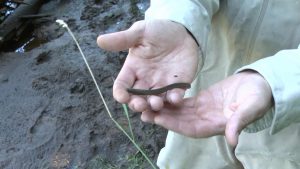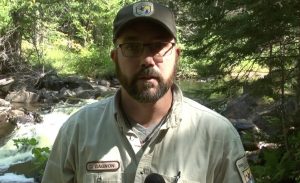 The US Fish and Wildlife Service is treating several area rivers and streams with a lampracide that ultimately protects the fish population of Lake Superior.
The US Fish and Wildlife Service is treating several area rivers and streams with a lampracide that ultimately protects the fish population of Lake Superior.
Often times, people confuse the US Fish and Wildlife Service with the Department of Natural Resources who regulates fish and game in the state of Michigan, but this group of men and women serve a much different purpose.
 “We’re up here in Hancock, Michigan treating a few streams. This one here, the Gratiot River, we’re treating Mud Lake outlet over byhe town of Gay, Michigan, and also the Graveraet River over toward Toivola, said Chris Gagnon of the US Fish and Wildlife Service. whose crew are currently stationed in the Keweenaw Peninsula with mobile labs, and a team of researchers who are making sure that fishing in Lake Superior remains the best that it can be, and they are doing so by battling a predator amongst these waters that nearly wiped out the fishing industry many years ago.
“We’re up here in Hancock, Michigan treating a few streams. This one here, the Gratiot River, we’re treating Mud Lake outlet over byhe town of Gay, Michigan, and also the Graveraet River over toward Toivola, said Chris Gagnon of the US Fish and Wildlife Service. whose crew are currently stationed in the Keweenaw Peninsula with mobile labs, and a team of researchers who are making sure that fishing in Lake Superior remains the best that it can be, and they are doing so by battling a predator amongst these waters that nearly wiped out the fishing industry many years ago.
Gagnon said, “As adults, sea lamprey will swim out into the Great Lakes where they’ll parasitize on the game fish species that we love, the lake trout and the salmon, for about a year and a half and then they’ll come back upstream as adults, spawn and repeat the whole life cycle over again.”
 Sea lamprey are not native to the Great Lakes. In the 1800’s the Welland Canal was created in Ontario, Canada. The Canal bypasses Niagara Falls, which created a shipping channel between Lakes Erie and Ontario allowing vessels to and from the upper Great Lakes to reach the Atlantic Ocean. As vessels increased in size, a wider and deeper shipping channel was needed to accommodate, and the retrofitting project of the canal began in 1913.
Sea lamprey are not native to the Great Lakes. In the 1800’s the Welland Canal was created in Ontario, Canada. The Canal bypasses Niagara Falls, which created a shipping channel between Lakes Erie and Ontario allowing vessels to and from the upper Great Lakes to reach the Atlantic Ocean. As vessels increased in size, a wider and deeper shipping channel was needed to accommodate, and the retrofitting project of the canal began in 1913.
Gagnon said, “Once we opened up that, canal lampreys were able to freely swim up to the Great Lakes.’
Over the next twenty five years lamprey had made their way into all five of the Great Lakes.
“After the sea lamprey invaded the Great Lakes, it didn’t take very long for them to really decimate the lake trout population, extirpating them in Lake Michigan and in Lake Superior, nearly wiping them out. So what we do is very important to the fisheries and the economics of the Great Lakes,” he said.
With lake trout near extinction in the 1950’s, the Great Lakes Fishery Commission was formed as a joint effort between the United Sates and Canada, whose goal was eradicating lamprey and reviving the fish population.
 Gagnon said, “By the 1950’s, early 60’s, we started treating streams after a lampricide was found that was effective on killing the larval sea lampreys.”
Gagnon said, “By the 1950’s, early 60’s, we started treating streams after a lampricide was found that was effective on killing the larval sea lampreys.”
With over 50 years of data collection, the efforts of the US Fish and Wildlife Service have lamprey control down to a science. Biologists monitor pH levels, stream conditions, and lamprey population estimations. They then use that data to calculate when and how much treatment is needed to maintain the proper balance that will not harm fish or plants in the watershed. The lampricide is also said to be nonharmful to humans.
Generally speaking, once a stream is treated it doesn’t need to be retreated for three to five years, such as the case with the Gratiot River.
“2015 was the last time we treated this river after they found lamprey in here. Since then, lamprey have been found again in this stream so we’re back here to retreat it,” said Gagnon.
Gagnon and his crew will be working in the area for a few more days before heading to other parts of the Lake Superior watershed and continuing their mission.
 Keweenaw Report Your Source for Local News and Sports
Keweenaw Report Your Source for Local News and Sports





